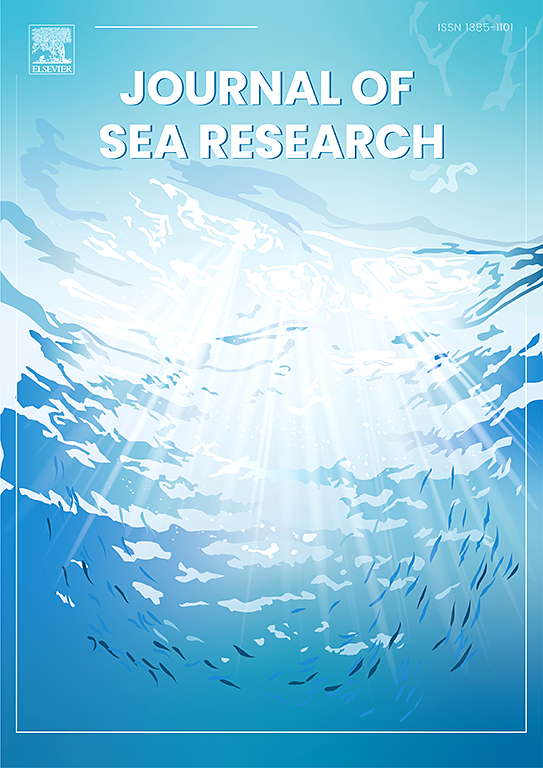Possible evidence of range expansion of the tropical ghost crab Ocypode ceratophthalmus to a temperate region driven by climate change
IF 2.9
4区 地球科学
Q2 MARINE & FRESHWATER BIOLOGY
引用次数: 0
Abstract
Recent rapid climate change caused by global warming has significantly affected marine organisms, and species normally found in tropical zone have been reported in temperate zones. This cryptic range expansion may influence ecosystems due to interspecific competition for habitats, prey, and population reproductive resources with native species. In September 2021 and August 2022, we identified the tropical ghost crab species Ocypode ceratophthalmus in the southern region of the Korean Peninsula. To date, only three species of ghost crabs, O. stimpsoni, O. cordimana, and O. sinensis, had been reported. Morphologically, all specimens of O. ceratophthalmus possess a stridulating ridge composed of two parts of circular and horizontal lines but lack prolonged eyestalks. Species identification was confirmed using a partial sequence of the mitochondrial cytochrome c oxidase subunit I (mtCO1) gene for each individual given their morphological immaturity. Additionally, population genetic analyses using the mtCO1 and nuclear sodium‐potassium ATPase α-subunit (NaK intron) genes revealed the high genetic connectivity between Korean populations and the neighboring populations in Northeast Asia. The results of the neutrality test and mismatch distribution indicated that the Jeju population in South Korea experienced a recent population expansion. Given the oceanic flow of the Kuroshio Current and the smaller currents branching off, the genetic homogeneity of populations is anticipated to be a result of continuous immigration of individuals from more southern localities. These findings provide pivotal insights into the habitat expansion of the tropical crabs into temperate zones. Additionally, they inform conservation strategies for native crabs by enabling effect-based estimation of species range expansion and settlement.
气候变化驱动下热带鬼蟹向温带扩张的可能证据
近年来,全球变暖引起的快速气候变化对海洋生物产生了重大影响,热带地区常见的物种已经出现在温带地区。由于与本地物种在栖息地、猎物和种群生殖资源方面的种间竞争,这种隐蔽的范围扩张可能会影响生态系统。在2021年9月和2022年8月,我们在朝鲜半岛南部地区发现了一种热带鬼蟹。迄今为止,只报道过三种鬼蟹,即O. stimpsoni、O. cordimana和O. sinensis。在形态学上,所有的角眼眼标本都有一个由圆线和水平线两部分组成的鸣脊,但没有延长的眼柄。利用线粒体细胞色素c氧化酶亚基I (mtCO1)基因的部分序列对每个个体进行了物种鉴定,因为它们的形态不成熟。此外,使用mtCO1和核钠钾atp酶α-亚基(NaK内含子)基因进行的群体遗传分析显示,韩国人群与东北亚邻近人群之间存在高度的遗传连通性。中性检验和错配分布结果表明,韩国济州岛人口近期经历了一次人口扩张。考虑到黑潮的海洋流动和较小的洋流分支,预计种群的遗传同质性是来自更南部地区的个体不断移民的结果。这些发现为热带螃蟹向温带的栖息地扩张提供了关键的见解。此外,它们通过对物种范围扩展和定居进行基于效应的估计,为本地螃蟹的保护策略提供信息。
本文章由计算机程序翻译,如有差异,请以英文原文为准。
求助全文
约1分钟内获得全文
求助全文
来源期刊

Journal of Sea Research
地学-海洋学
CiteScore
3.20
自引率
5.00%
发文量
86
审稿时长
6-12 weeks
期刊介绍:
The Journal of Sea Research is an international and multidisciplinary periodical on marine research, with an emphasis on the functioning of marine ecosystems in coastal and shelf seas, including intertidal, estuarine and brackish environments. As several subdisciplines add to this aim, manuscripts are welcome from the fields of marine biology, marine chemistry, marine sedimentology and physical oceanography, provided they add to the understanding of ecosystem processes.
 求助内容:
求助内容: 应助结果提醒方式:
应助结果提醒方式:


